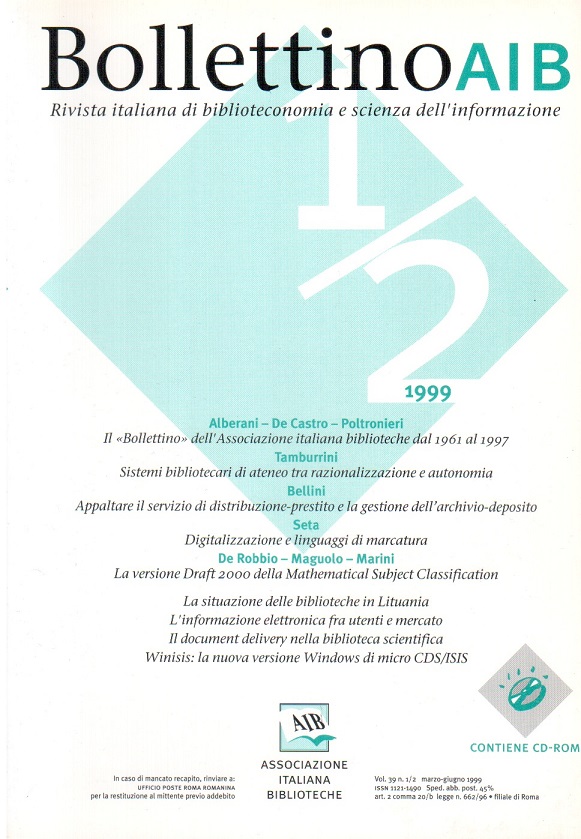University library systems between rationalisation and autonomy: the case of the University of Pisa
Main Article Content
Abstract
The University of Pisa's library services differ little from those of the average Italian university. The university library system has considerable bibliographic resources, scattered among many centres, with uneven service levels. Compared with other university systems, the most important variable is the presence, within just a few kilometres, of other important libraries linked to the university and to research.
The University of Pisa has modified the management and computerisation of its libraries to achieve a comprehensive network of services.
Although the process of change, itself a result of a convergence of new policies and management, and professional culture, is still only in progress, it is, however, producing a promising series of results and prospects for the future.
The university Committee for libraries, which was set up in 1987, has produced a number of proposals for reorganisation, based on a certain amount of centralisation and on the introduction of more widely based, and also more innovative and advanced computerised services. New rules for libraries, together with a centralised library service, were thus introduced.
In early 1999, the university, building on the library policy which pursued in the preceding decade, considered a further development of the system based on:
a) modification of the University Statute to recognise only those libraries organised in the central library service as part of the library system;
b) a centralisation process to achieve, by September 2000, the establishment of 15 central library services for large subject areas, co-ordinated by the university's library system service;
c) a set of guidelines with standards for the library services and the main objectives of the system.
The system's policy direction is given by the academic bodies through the university Committee for libraries, which consists of representatives of the academic senate and of the administrative council, with additional input from specialists. Technical co-ordination is the task of the university library system service, which is directly responsible for shared cataloguing, proposals for professional training and seminars, standards and statistics and collection of data as a whole, and computerisation and university databases. It also assists the libraries on all other aspects of management and organisation. The individual libraries, which are financially independent, have a board, a president and a managing director. As regards human resources, a reorganisation of library staff has taken place following the planning of duties.
As regards financial resources, all the libraries recognised as centres are financed by the interested faculty and departments, and receive additional University funding on the basis of 6 parameters: number of potential users (teaching staff; students); department/faculty funding per potential user; weekly opening hours; workload (current serials subscriptions; new acquisitions).
The University has established a series of objectives considering firstly the public services, then the guidelines for library services, the system's tasks, the essential criteria and the standards for the principal services.
Similarly, staff training has initiated courses that aim to involve all the staff in the library system's perspectives, to place the emphasis on services and users to attain the best quality, and to increase professional skills.
As regards automation, there are at present various systems and many databases, merged in a Web metaOPAC of some 300.000 bibliographic records representing 25% of the University's collection. In the main libraries the coverage of online catalogues ranges from 50% to 90% and automated systems are in use also for loans, serials control and acquisitions. The University has planned a migration, within 12-18 months, to a single automated system, with client/server architecture and a graphic interface.
As regards database networking, we have activated an ERL server with some general databases and also initiated an interesting co-operation programme with the Scuola Normale Superiore, the Scuola Superiore S. Anna and the National Research Council.
As regards document delivery, the growth of demand led to the choice of the Ariel system for the central library services.
The management model is based on:
1) the centralisation of policies, standards, statistics and evaluation, system and database management and staff training;
2) the devolution of the management of staff and services to the 15 libraries.
Feedback comes from the evaluation of services and results. We can say that this model arises from the concrete experience and the past evolution of university libraries. The objective is to reorganise libraries, improving their quality and user orientation.
Article Details

This work is licensed under a Creative Commons Attribution-ShareAlike 4.0 International License.
